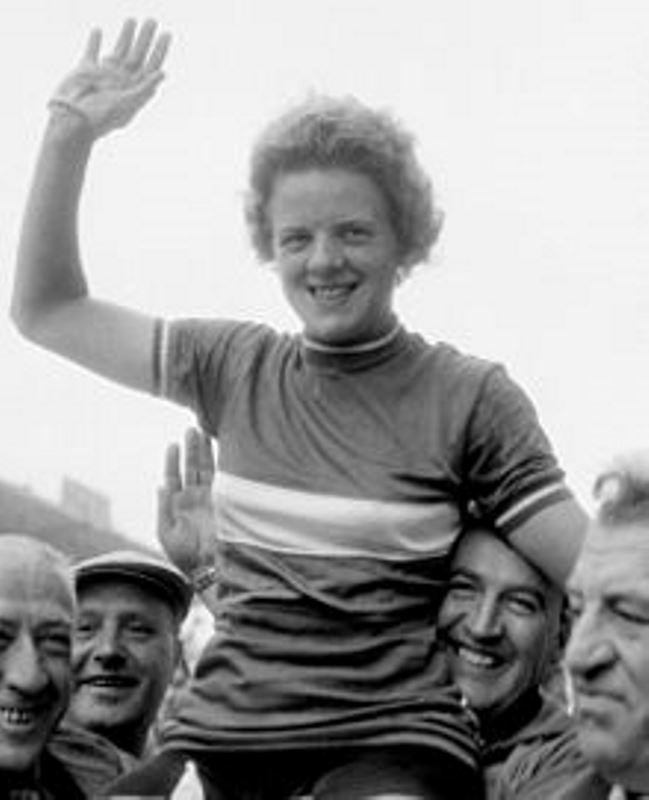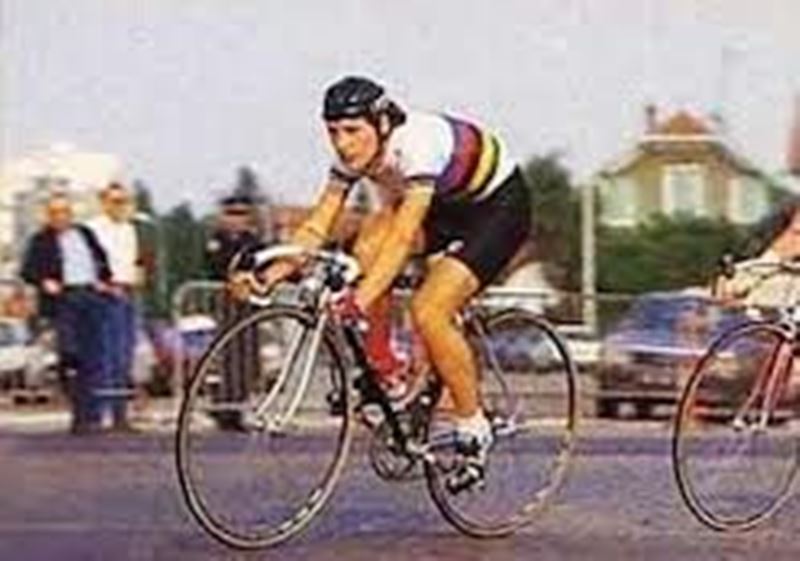
The professional cycling peloton is a bright spectacle, with riders sporting different jerseys that create a vibrant palet of colours.
Within this muddled blur of shades, some elements in particular stand out: for example the jerseys of the ranking leaders in the Grand Tours and the colours of the different National Champions. But one uniform that remains truly recognisable throughout the year is the rainbow jersey with its distinctive coloured stripes.
What the colours mean
The rainbow jersey is the symbol of the reigning UCI World Champion and it’s the same main design across all the different cycling disciplines: road, track, cyclo-cross, mountain bike, BMX Racing, BMX Freestyle, indoor cycling and trials. It’s extremely easy to recognise with its full white background and five characteristic horizontal coloured hoops, from top to bottom: blue, red, black, yellow and green. These are the same colours as the Olympic flag as imagined by Baron de Coubertin in 1913 and which represent the five continents of Europe, Asia, Africa, Oceania and America.
For the road discipline, the rainbow jersey is awarded in the road race and individual time trial to the winning Elite, Under-23 (men only) and Junior riders as well as the fastest nation in the new team time trial mixed relay. Jerseys are also awarded at the UCI Para-cycling Road World Championships in the different classes of the road race and individual time trial as well as the mixed handbike team relay.
The UCI’s long-standing Italian partner Santini, which is currently helping the fight against the COVID-19 pandemic by making protective face masks has been producing these rainbow jerseys since 1994.
Reigning UCI World Champions are entitled to wear the rainbow jersey for the full year until the following UCI World Championships – but only when competing in the discipline, category and speciality for which they won it. For example, Men Elite road race UCI World Champion Mads Pedersen (Denmark) cannot wear his rainbow jersey in the individual time trial, which was won last year by Australian Rohan Dennis.
Meanwhile former UCI World Champions have the privilege of displaying rainbow bands on the sleeves and on the collar of their team jersey, to recognise their past victory – again, only in the speciality in which it was won.
Alfredo Binda, the first ever rainbow jersey winner
Italian Alfredo Binda was the winner of the first rainbow jersey, in 1927, the year the UCI World Championships were opened up to professional cyclists.
The race was organised in Germany at the legendary Nürburgring circuit. Until that year the UCI World Championships had been reserved for amateurs.So in 1927, the UCI decided to hold a single race with two classifications: amateurs and professionals. The route was extremely tough: eight laps of 22.8km – for a total of 182.4km –packed with climbs, descents and corners.
No wonder it took a champion as great as Alfredo Binda to put in a huge performance on that cold and wet 21 July. Binda broke away after just 30km on the climb of Karussell to finish in 6:37.29 at an impressive average speed of 27.55km/h. He won from two other Italians: Costante Girardengo at 7.16 and Domenico Piemontesi some 10.51 down, while another Azzurro Gateano Belloni, finished fourth at 11.11.
The amateur race went to the Belgian Jean Aerts, who finished fifth overall, ahead of the German Rudolf Wolke and Italian Michele Orecchia. Of the 55 riders who started, just 18 finished.
 Elsy Jacobs, the first woman to wear the rainbow jersey
Elsy Jacobs, the first woman to wear the rainbow jersey
Only in 1958 did the rainbow jersey officially enter the world of women’s cycling. The first rider to wear it was Elsy Jacobs from Luxembourg after her success in the road race in Reims, France, on 3 August 1958.
Jacobs finished in front of the two Soviet riders Tamara Novikova and Mariya Lukshina – both at 2.51. On 9 November the same year she went on to break the women’s Hour Record with a mark of 41,347m at the Vigorelli velodrome in Milan – a record that stood for 14 years.
Elsy came from a cycling family, and her brothers Roger, Raymond and Edmond all turned pro and raced in the Tour de France. In her honour there is a race named the Festival Elsy Jacobs held in her hometown in Garnich which has been part of the UCI Women’s Elite cycle racing calendar since 2008.
Jacobs’ performances can be regarded as evidence against the theory of the “curse of rainbow jersey” which suggests that after becoming UCI World Champion a rider suffers poor luck the following year. It’s true that some winners have been badly injured – from Tom Simpson in 1966 to Stephen Roche in 1988, Luc Leblanc in 1995 and Alessandro Ballan in 2009. There have also been some tragedies including the deaths of the young Jean-Pierre Monseré in 1971.
But it’s not fair to suggest the blame lies with the rainbow jersey. Eddy Merckx, Bernard Hinault and Greg LeMond all won the Tour de France while UCI World Champions. Also Thor Hushovd, Mark Cavendish, Tom Boonen and Peter Sagan performed very well in the years following their wins.
 Rainbow jersey records
Rainbow jersey records
There are a few male riders who have won UCI Road World Champion’s titles in two successive years: the Belgians Georges Ronsse (1928-29), Rik Van Steenbergen (1956-57) and Rik Van Looy (1960-61); the Italians Gianni Bugno (1991-92) and Paolo Bettini (2006-07) and Slovakia’s Peter Sagan who is the only man in the history with three straight titles from 2015 to 2017.
Other men with triple victories are the Italian Binda (1927, 1930, 1932), Van Steenbergen (1949, 1956, 1957), the Spaniard Óscar Freire (1999, 2001, 2004), and the “Cannibal” Eddy Merckx (1967, 1971, 1974). Belgium is the most successful country in UCI Men’s Road World Championships history, with 26 wins, ahead of Italy with 19 and France, 8.
There is no doubt who is the most successful among Women’s road race UCI World Champions: the Frenchwoman Jeannie Longo won five times (1985-87, 1989, 1995) including four in a row, since 1988 the race was not held. Belgium’s Yvonne Reynders won four times (1959, 1961, 1963, 1966), and Dutchwoman Marianne Vos three times (2006, 2012, 2013) including two consecutive titles like Soviet Anna Konkina (1970-71), the Netherlands’ Leontien van Moorsel (1991 and 1993, there being no race in 1992), the Swede Susanne Ljungskog (2002-03), and the Italian Giorgia Bronzini (2010-11). The Netherlands is the most successful country in UCI Women’s Road World Championships, with 12 wins, ahead of France with 10 and Belgium, 6.
Regarding individual time trials, among the men the Swiss Fabian Cancellara (2006, 2007, 2009 and 2010) and German Tony Martin (2011, 2012, 2013 and 2016) have won the most events. Meanwhile Jeannie Longo from France won four times as an Elite Woman (1995, 1996, 1997 and 2001).
Few riders succeed in becoming UCI World Champions across different disciplines. Pauline Ferrand-Prévot wrote a page of cycling history during the 2015 season, when, at just 23 years old, she became the first person – man or woman – ever to simultaneously hold three titles: road, cyclo-cross and mountain bike. In that unique feat the French rider outshone even those other supremely talented athletes who have won different rainbow jerseys like Marianne Vos (road, cyclo-cross, MTB and track) or Mathieu Van der Poel (cyclo-cross and MTB).- www.uci.ch


































